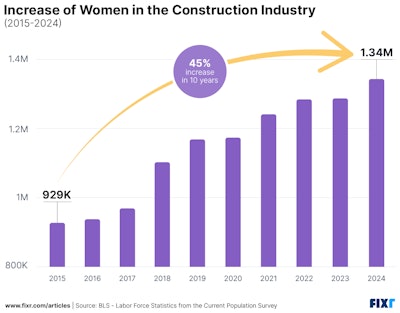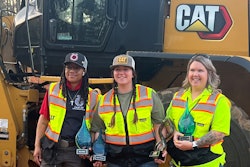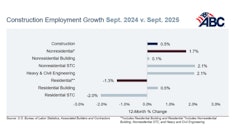
Ever since the industry began, jobs in the construction industry were notoriously seen as men’s jobs. While more women have started joining the industry, there is still a major discrepancy between the two genders. Women in construction (WIC) have come a long way but there is still a lot of work to be done before women are well-represented in the construction industry.
In honor of Women in Construction Week and Women’s History Month, here are five things you should know about women in the construction industry:
1. Only 14% of Construction Workers are Women
Although it is estimated that 1 in 7 construction jobs in 2024 went to women, they only make up about 14% of the industry. Data collected last year by the U.S. Department of Commerce Office of the Under Secretary for Economic Affairs (OUSEA) shows that when considering major industry employment levels of workers with less than a bachelor’s degree, construction had the lowest number of women employees. When looking at employees with less than a bachelor’s degree, women only make up 9% of the construction industry.
2. Women Dominate Construction Administration Roles
In the construction industry, women are a minority but when considering office and administrative roles, women make up 80%. This data collected by the U.S. Bureau of Labor Statistics essentially shows that while men outweigh women in field-oriented jobs, women have taken the lead in office-type jobs.
Unfortunately, with only 1.3 million women vs 10 million men being in construction, women only account for 3.5% of repair jobs and 2.0% of maintenance jobs.
3. The Number of Women in the Industry has Increased
Over the past decade, the number of women in the construction industry has increased significantly. At the end of February, Fixr released a data report covering the key insights and statistics for women in the construction industry. In the report, it was shared that the number of women in construction from 2015 to early 2025 has grown from 929,000 to 1,343,000. In contrast to the majority of numbers often pointing to there being a scarcity of women in construction, this data shows an expansion of women in the industry.
4. There are Lots of Scholarship Opportunities for WIC
Due to the lack of women in construction, there have been many companies in the industry that have created scholarship opportunities for women interested in entering the field. Doing a quick search on the internet will bring you multiple websites announcing and sharing their own or various other scholarships. This is a great doorway for those who are already interested in the industry and to draw interest from for those who may not have considered construction before.
5. The Construction Industry Offers a Narrower Pay Gap
While women in all industries across the United States are exposed to a pay gap between themselves and their male counterparts, the gap in the construction industry is smaller than in other industries.  Fixr
Fixr
Although this is still a pay gap, it is narrower than the gap across industries. Women will still have to work to get this gap to disappear, but progress like this is quite significant.
Women Constructing a Difference
There are still not nearly enough women in the construction industry and if more women considered construction, the trades labor shortage would likely shrink appreciably. There are lots of things you can do to support WIC, staying educated and supportive are great places to start.
ForConstructionPros.com and its affiliate brands announced the winners of its first PACER award at the end of last year. One of its four categories was Women in Construction. The WIC category had four winners:
- Laurie Bryan, construction manager at Allan Myers
- Beth Conley, sales manager at Superior Asphalt Materials
- Lizabeth Howard, senior project manager at Superior Construction
- Jennifer Edgerton, operations manager at Driveways By Us Inc.
Awarding these women the PACER award helps promote the sharing of stories of excellence about women in the construction industry.
You can learn more about Women in Construction Week here.




















